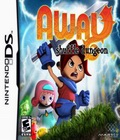Genre: Role-Playing Game
Publisher: Majesco
Developer: Mistwalker
Release Date: October 2008
Last year at GDC, Hironobu Sakaguchi was at Microsoft's hotel talking up Lost Odyssey. He was seriously jet-lagged and, in response to another reporter's question, mentioned that Mistwalker Games' next project was going to be a DS game. He was promptly hushed by a PR agent.
Away: Shuffle Dungeon is apparently that project, with character design by Sakaguchi and music composed by Final Fantasy legend Nobuo Uematsu. Unsurprisingly, it's an RPG; specifically, it's an action-RPG starring a brash young hero named Sword. (The name is meant to evoke a sort of back-to-basics approach, similar to the original Dragon Warrior or Final Fantasy, where the hero's name would be Hero.)
For the last hundred years, aliens have been systematically abducting people and stealing buildings from your village. One day, Sword's girlfriend is taken, leaving him as the last person there. Sword, as one might expect, sets out to retake what the aliens have taken, one person or thing at a time. Every time you clear a dungeon, you free one of the villagers, bringing him or her back to the village along with his or her house. This also opens the next dungeon for exploration, as well as reopening shops along the way.
The "shuffle dungeons" of the title are pretty simple to describe. Each screen in a given dungeon is split in half across the DS' two screens. You can move between them freely, but each half will rotate off-screen in 10 seconds in alternating order, to be replaced shortly by a randomly chosen chunk of the map; the dungeons themselves aren't randomly generated, but the order in which you see the screens are. If you're on a screen when it shuffles off-screen, you'll take damage.
Without the rotation gimmick, Away would be a solid action-RPG in the mold of the old-school Zelda games, such as Link's Awakening. There would be nothing wrong with it, save for a certain sense of déjà vu.
With the rotation gimmick, it's actually intense. You have, at most, 20 seconds to accomplish anything on either screen, so it's a mad dash toward switches, treasure chests or enemies, with narrow escapes as a routine occurrence. There are around 20 shuffle dungeons in the final version of the game, and even the first one we saw could be surprisingly challenging.
You're assisted in this by the presence of multicolored fupongs (named such by Sword after the sound they make when they move), small blobs that you can find throughout a dungeon. Each fupong you find follows you around obligingly and can be sent after an enemy with the touch of a button. Their individual magical capabilities are determined by their color, and when used, they turn gray for a certain period of time, preventing them from being immediately reused. While we didn't get to see this in action, the fupongs can be raised and improved over the course of the game, making them more powerful and enabling you to use a single fupong more than once before it turns gray.
At the end of a dungeon, you'll face a boss on a 3-D plane; the E3 demo put us up against a giant monster that attacked with waves of energy, which could only be damaged by attacks to the gem just under its face. It was challenging in a very simple sort of way; you could tell what you had to do almost immediately, but getting there was the trick.
Away is one of the games coming out of E3 with a relatively low amount of hype. Some of this could probably be attributed to its being a Majesco project; Majesco's booth was mostly dedicated to ultra-casual gaming with titles like the new Cooking Mama, so most of the press who would go nuts for a game like this might've been tricked into staying away. It's officially a well-kept E3 secret, although I'd imagine its pedigree means we'll be seeing a lot more about it as it moves toward launch.
More articles about Away: Shuffle Dungeon











 Away: Shuffle Dungeon is a new RPG from Mistwalker, known for Lost Odyssey and Blue Dragon, where you take control of the young hero Sword, sole resident of the once booming Webb Village, who must rescue as many kidnapped townsfolk as possible from a mysterious unknown that has been slowly spiriting them away.
Away: Shuffle Dungeon is a new RPG from Mistwalker, known for Lost Odyssey and Blue Dragon, where you take control of the young hero Sword, sole resident of the once booming Webb Village, who must rescue as many kidnapped townsfolk as possible from a mysterious unknown that has been slowly spiriting them away.































